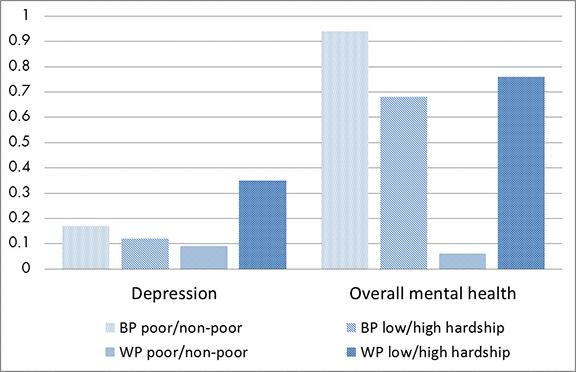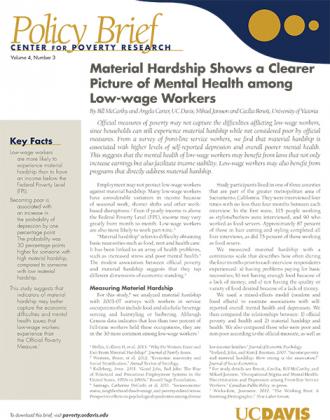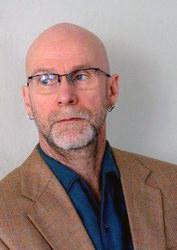Material Hardship Shows a Clearer Picture of Mental Health among Low-wage Workers
By Bill McCarthy and Angela Carter, UC Davis; Mikael Jansson and Cecilia Benoit, University of Victoria
Official measures of poverty may not capture the difficulties afflicting low-wage workers, since households can still experience material hardship while not considered poor by official measures. From a survey of front-line service workers, we find that material hardship is associated with higher levels of self-reported depression and overall poorer mental health. This suggests that the mental health of low-wage workers may benefit from laws that not only increase earnings but also facilitate income stability. Low-wage workers may also benefit from programs that directly address material hardship.
Employment may not protect low-wage workers against material hardship. Many low-wage workers have considerable variation in income because of seasonal work, shorter shifts and other work-based disruptions.[2] Even if yearly income is above the Federal Poverty Level (FPL), income may vary greatly from month to month. Low-wage workers are also more likely to work part-time.[3]
Key Facts
- Low-wage workers are more likely to experience material hardship than to have an income below the Federal Poverty Level (FPL).
- Becoming poor is associated with an increase in the probability of depression by one percentage point. The probability was 30 percentage points higher for someone with high material hardship, compared to someone with low material hardship.
- This study suggests that indicators of material hardship may better capture the economic difficulties and mental health issues that low-wage workers experience than the Official Poverty Measure.[1]
“Material hardship” refers to difficulty obtaining basic necessities such as food, rent and health care. It has been linked to an array of health problems, such as increased stress and poor mental health.[4] The modest association between official poverty and material hardship suggests that they tap different dimensions of economic standing.[5]
Measuring Material Hardship
For this study,[6] we analyzed material hardship with 2003-07 surveys with workers in service occupations that include food and alcoholic beverage serving and hairstyling or barbering. Although Census data indicates that less than two percent of full-time workers held these occupations, they are in the 30 most common among low-wage workers.[7]
Study participants lived in one of three counties that are part of the greater metropolitan area of Sacramento, California. They were interviewed four times with no less than four months between each interview. In the first wave, 115 people working as stylists/barbers were interviewed, and 90 who worked as food servers. Approximately 87 percent of those in hair cutting and styling completed all four interviews, as did 75 percent of those working as food severs.
We measured material hardship with a continuous scale that describes how often during the four months prior to each interview respondents experienced: a) having problems paying for basic necessities; b) not having enough food because of a lack of money; and c) not having the quality or variety of food desired because of a lack of money.
We used a mixed-effects model (random and fixed effects) to examine associations with self-reported overall mental health and depression. We then compared the relationships between: 1) official poverty and health and 2) material hardship and health. We also compared those who were poor and non-poor according to the official measure, as well as differences when individuals entered or left poverty.
Low-wage Work and Material Hardship
At the first wave of interviews, the median monthly household income (wages and tips) was $2,040 for servers and $2,256 for stylists/barbers. Incomes fluctuated. Servers’ median income fell throughout the study to $1,830 (wave 2), $1,460 (wave 3) and $1,100 (wave 4), whereas stylists’ median income fell to $1,934 (wave 2), rose to $2,490 (wave 3), then fell to $2,144 (wave 4).
At wave 1, about five percent of those in food and alcoholic beverage serving and three percent in hairstyling or barbering earned below FPL. For material hardship, in wave 1 approximately 20 percent of servers and eight percent of stylists had scores of two or greater (occupation means are 1.49 and 1.21, respectively). These people reported experiencing material hardship at least some of the time.
Having an income below 100 percent of FPL had non-significant associations with depression and poorer overall mental health, whereas people with higher scores for material hardship had significantly higher levels of both. The probability of depression was one percentage point higher for the poor relative to non-poor (see Figure 1 for between-person estimates). The probability was 29 percentage points higher for someone with high material hardship, compared to low material hardship.
People reporting an increase in material hardship also reported significantly higher levels of depression and poorer overall mental health, whereas becoming officially poor was not significantly related to changes in mental health. Becoming poor is associated with an increase in the probability of depression by one percentage point. The probability was 30 percentage points higher for someone with high material hardship, compared to someone with low material hardship.
These relationships between material hardship and mental health are independent of other variables that typically predict variation in mental health, such as age, gender, race, sexual orientation, nativity, income, access to health insurance, drug use and perceived stigma. These patterns are also independent of the respondent’s occupation.
Reducing Material Hardship
This study suggests that material hardship more adequately describes conditions associated with poorer mental health among low-wage workers than the Official Poverty Measure. Measuring a person or household’s material hardship and economic status multiple times a year would better capture precarious financial situations.
Programs such as food stamps, housing subsidies and discounts on utility bills, can address material hardship directly. Income instability is associated with material hardship and poor mental health among low-wage workers, and laws that stabilize hours and wages, including an increase to the minimum wage and guaranteed work hours, may mitigate these fluctuations.
Bill McCarthy is a Professor of Sociology at UC Davis.
Angela Carter is a Ph.D. student in Sociology at UC Davis.
Mikael Jansson is a Scientist at the Centre for Addictions Research BC and an Adjunct Assistant Professor in Sociology at the University of Victoria.
Cecilia Benoit is a Professor of Sociology at the University of Victoria and a Scientist at the Centre for Addictions Research BC.
[1] Heflin, Colleen H, et al. 2013. “Why Do Women Enter and Exit From Material Hardship?” Journal of Family Issues.
[2] Western, Bruce, et al. 2012. “Economic insecurity and Social Stratification.” Annual Review of Sociology.
[3] Kalleberg, Arne. 2011. “Good Jobs, Bad Jobs: The Rise of Polarized and Precarious Employment Systems in the United States, 1970s to 2000s.” Russell Sage Foundation.
[4] Santiago, Catherine DeCarlo, et al. 2011. “Socioeconomic status, neighborhood disadvantage, and poverty-related stress: Prospective effects on psychological syndromes among diverse low-income families.” Journal of Economic Psychology.
[5] Iceland, John, and Kurt J. Bauman. 2007. “Income poverty and material hardship: How strong is the association?” Journal of Socio-Economics.
[6] For study details see Benoit, Cecilia, Bill McCarthy, and Mikael Jansson. “Occupational Stigma and Mental Health: Discrimination and Depression among Front-line Service Workers.” Canadian Public Policy, in press.
[7] Wicks-Lim, Jeannette. 2012. “The Working Poor: A Booming Demographic.” New Labor Forum.
#povertyresearch













